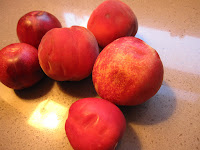As the season heats up and tomatoes start ripening as fast as you can say ‘ripe tomato’ those of us who planted lots of now healthy overproducing tomato plants realize we need to get creative about how to use all that luscious fruit! Of course we can simply can them, a good solution, or we can make salsas, pizza and marinara sauce or tomato jam, but then we start looking for other ideas…casseroles with tomatoes and eggplant, or lovely stuffed tomatoes that can create a meal in themselves. Well, yesterday, as I tried to jazz up what I was going to fix for dinner, I discovered a lovely recipe for a tomato galette. The basic recipe was in the book Chez Pannisse - Vegetables, by Alice Waters. Since I was doing a sort of spur of the moment dish, I made a substitution for the type of cheese and the color of the onions, and the result was delicious!
Tomato Cheese Galette
 Ingredients:
Ingredients: ½ recipe Galette Dough - see below
3 large, ripe tomatoes
2 medium red onions
1 bunch basil
8 oz mixed parmesan and mozzarella cheese
Extra virgin olive oil
Salt and pepper
Galette dough:
2 cups flour
½ tsp salt

¼ tsp sugar
6 oz unsalted butter
1/3 C ice water
First make the galette dough…
Combine the flour, salt and sugar (the sugar helps the pastry brown). The butter should be cool - not cold and hard, but not too soft, wither. Cut half the butter in to the flour mixture and work it in until the dough is roughly the texture of cornmeal - I did this using my hands as I seem to have better luck this way than using a fork -
Add the other half of the butter in marble-sized chunks. Work it into the dough very briefly, leaving the butter in unevenly incorporated bits.
Lightly fork in the ice water just until evenly moistened.
Divide and gather the dough into two balls, cover separately with plastic wrap and knead very lightly through the plastic wrap, forming the dough into two even disks. I always go ahead and make a full recipe and put the second disk in the freezer - nice to have that waiting for you when the galette bug next hits!

Refrigerate the dough and let it rest at least 1 hour.
Tomato galette:
Roll out the pastry dough to a circle about 12 inches in diameter. Place it on a baking sheet without sides, lined with parchment paper, set aside.
Cut out the stem end of the tomatoes and slice them 1/8 inch thick. Set aside on a towel to drain.
Peel and slice thin the onions and sauté them in olive oil until softened. Season with salt and pepper and a handful of the basil leaves, chopped. Let cool completely.
Preheat oven to 375 degrees
Take the circle of dough and sprinkle with half the cheese, grated. Spread the cooled onions over the cheese, leaving a 1-inch border around the edge.
 Put a layer of whole basil leaves on top of the onions
Put a layer of whole basil leaves on top of the onionsArrange the tomato slices, slightly overlapping, on top.
Season with salt and pepper
Sprinkle over the rest of the cheese and drizzle generously with olive oil.
Working around the circle of dough, fold the edge of the dough up and over to make a shell around the filling.
Bake for 50 minutes to an hour on the bottom rack of the oven, until the bottom of the crust is well browned.
Take the tart out of the oven and immediately slide it off the baking sheet and parchment paper and onto a cooling rack - leaving it on the pan will cause the crust to ‘steam’ and get too soft.
Garnish with the rest of the basil leaves and drizzle with ore olive oil. Slice and serve immediately as a first course or as we did as a side with chicken or fish and a light salad.
Very summery faire and yet another way to take care of some of those wonderful tomatoes!

















































